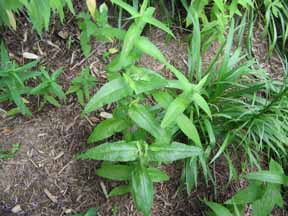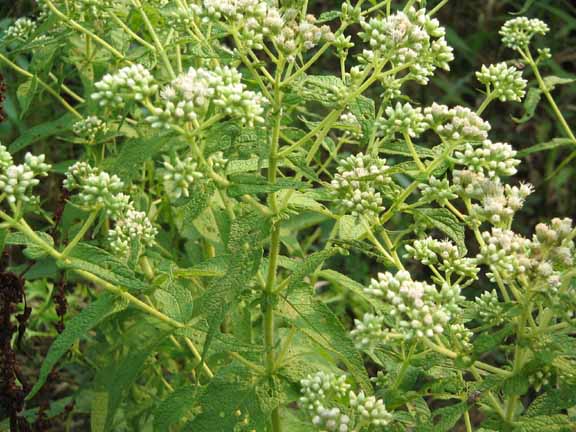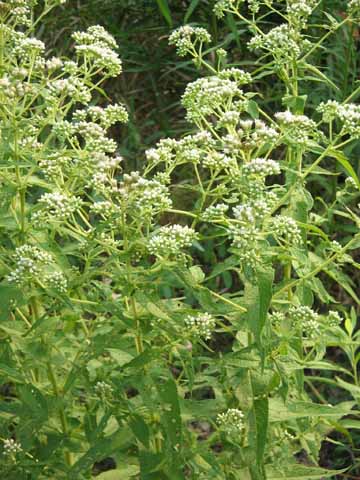Plants and People Project
Boneset - Eupatorium perfoliatum
Nicknames: Ague weed, Crosswort, Feverwort, Indian sage, Sweating plant, Thoroughwort, Vegetable Antimony
A strong, hot tea of boneset can induce vomiting and cause the evacuation of the bowels. The name boneset comes from an early belief that it would cause the rapid setting of broken bones. The Herbalist
Native Americans used a tea made from boneset to fight fevers and colds. Seneca Indians used it as an antimalarial. Smithsonian Institution - National Zoo
During the 1793 yellow fever epidemic, Philadelphia physicians used boneset to treat the patient's fevers. Herb Database
Boneset tea was widely used during the flu epidemics of the 19th and 20th centuries. It induced a sweating that brought down fevers. Current research suggests that it does boost the immune system. Peterson Field Guides Eastern/Central Medicinal Plants
Boneset root fibers were applied to hunting whistles, believing they would increase the whistle's ability to call deer. ETHNOBOTANICAL USE OF PLANTS
"It is stated that the popular name Boneset is derived from the great value of this remedy in the treatment of a species of influenza which had much prevailed in the United States, and which from the pain attending it was commonly called Break-Bone Fever.." Botanical.com
"The plant, however, should be used with some caution since large doses are laxative and emetic and the plant might contain potentially liver-harming pyrrolizidine alkaloids." Plants For A Future
CAUTION: Do not eat fresh boneset. It contains a toxic chemical (tremerol), which causes nausea, vomiting, weakness, muscle tremors, increased respiration, and at high doses, possibly even coma and death. Drying the herb eliminates the tremerol and the possibility of poisoning. Indian Spring Herbal Encyclopedia
"Boneset was used by many tribes of North America for a wide variety of ailments, including colds, sore throat, fever, flu, chills, epilepsy, kidney trouble, rheumatism, and to induce vomiting. The Mesquakies used the root to cure snakebites. One of their doctors, named McIntosh, used a leaf and flower tea to expel worms. The Iroquois, Mohegan, Menominee, Delaware, and Cherokee have all used boneset to treat colds and fever. The Alabama relieved stomachache with boneset tea. It was also used by several tribes, including the Cherokee, as a laxative." Innvista.com
DISCLAIMER: These pages are presented solely as a source of INFORMATION and ENTERTAINMENT. No claims are made for the efficacy of any herb nor for any historical herbal treatment. In no way can the information provided here take the place of the standard, legal, medical practice of any country. Additionally, some of these plants are extremely toxic and should be used only by licensed professionals who have the means to process them properly into appropriate pharmaceuticals. One final note: many plants were used for a wide range of illnesses in the past. Be aware that many of the historical uses have proven to be ineffective for the problems to which they were applied.
Identification and other facts / More facts / PLANTS database
Boneset

Flowers

Leaves
